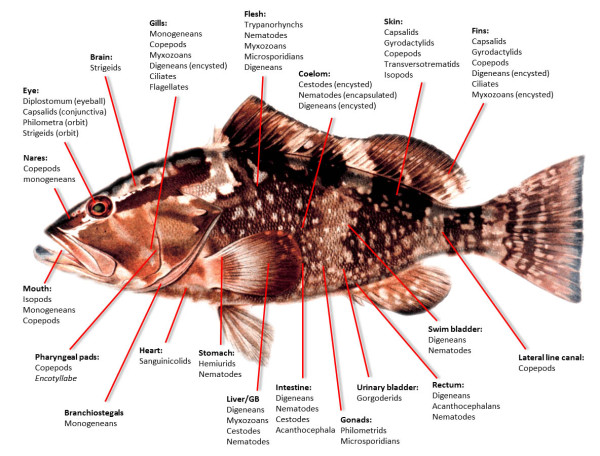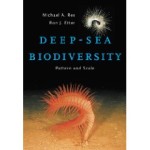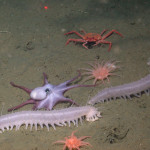
Tongue biters have been in my inbox a few times lately. If you’ve managed never to come across these interesting little isopods before, they are members of a wholly parasitic group called the Cymothoidae. For regular readers of Deep Sea News, you can think about them as smaller versions of Bathynomus, which they resemble a lot, the main difference being, you know, that whole sucking-the-life-out-of-a-fish-through-its-tongue thing. There’s quite a few species and they are widely distributed around the world in fishes from salt water and fresh water alike. What really interests me about these perennial visitors to my newsfeed is that people seem to be singularly horrified by them, whereas I don’t find them the least bit repulsive or even surprising in any way. To me, they are just another critter that has found a niche to occupy; I guess that’s the parasitologist in me (long before I studied whale sharks, I studied the ecology of parasitism).
In any sort of systematic parasitology training, you quickly realize – or are explicitly taught – that the presence of critters like the tongue biter is not unusual. Indeed, most wild fish harbour several species of parasites simultaneously and this is totally and completely normal. This seems to be a really hard concept for a lot of people to wrap their heads around. Parasites are assumed to be unusual and bad, a sign that things are seriously amiss. It’s tempting to look at the host of that tongue biter and think “there goes an evolutionary loser – an animal that fell prey to a repulsive little parasite”. But that’s not how it works at all. In fact, if you can survive and thrive despite your parasite burden, then you are an evolutionary winner, an idea that was formally codified as the Hamilton-Zuk hypothesis, based on studies of parasitism and plumage in birds. The corollary of this is that parasitism is a constant and normal part of the evolutionary pressures acting on an animal, and for that to be the case, parasitism has to be not only normal but positively common. And so it is. We just don’t notice it, because for the most part parasites are cryptic, they are literally out of sight and out of mind. It’s only when something as glaringly obvious as a tongue biter comes along that we even notice parasites at all, even though that same fish may well host a half a dozen other species at the same time.
 No fish is an island. When I snorkel on a Pacific reef, I don’t swim along and see mother-in-law Diagramma labiosum, I see one of the superstars of parasitology. When I used to study these drabbest of reef fishes in the lab of my PhD advisor Tom Cribb, we had counted sixteen different trematode worm species in the digestive tract alone. There were also monogenean worms on the outside: a different species for each fin, several on the gills and even one that specialized on the pharyngeal tooth pads (a tough place to live indeed). There were also parasitic copepods of several varieties and a dozen protozoans of varied flavours throughout the tissues. Oh yeah, there was also an enormous amphilinid – a bizarre worm distantly related to tapeworms – that lived in the body cavity. All in all, every individual Diagramma was a swimming hotspot of parasite biodiversity, and seeing a school of them together was like looking at a rainforest; you just needed a dissecting scope and some iris scissors so you could see the trees in the forest.
No fish is an island. When I snorkel on a Pacific reef, I don’t swim along and see mother-in-law Diagramma labiosum, I see one of the superstars of parasitology. When I used to study these drabbest of reef fishes in the lab of my PhD advisor Tom Cribb, we had counted sixteen different trematode worm species in the digestive tract alone. There were also monogenean worms on the outside: a different species for each fin, several on the gills and even one that specialized on the pharyngeal tooth pads (a tough place to live indeed). There were also parasitic copepods of several varieties and a dozen protozoans of varied flavours throughout the tissues. Oh yeah, there was also an enormous amphilinid – a bizarre worm distantly related to tapeworms – that lived in the body cavity. All in all, every individual Diagramma was a swimming hotspot of parasite biodiversity, and seeing a school of them together was like looking at a rainforest; you just needed a dissecting scope and some iris scissors so you could see the trees in the forest.
In my PhD studies (which seem to be receding in the rearview mirror altogether too fast these days!), I looked at far more modest critters. While a Diagramma might weigh a good 5-10lbs, the fishes I did for my dissertation were little goby-like and minnow-like fresh water jobbies that occur in Australia’s species poor temperate rivers. Even there, the average parasite richness in a 5 cm/2 inch fish was close to five species per individual. Fish size does make a difference, but the truth is that if there is a fish swimming, then one, and more likely many more, parasite species has made its home there. I have never heard of a fish that does not host any parasites at all and I doubt that such a fish exists.
The implications of this for global diversity are profound. If there are 28,000 species of bony fishes, and each has at least 5 unique parasite species, then those 28,000 fishes scale up to 140,000 species of parasites. If you use more aggressive (I would argue realistic) estimates of parasite richness, then it’s easy to get estimates of a quarter of a million species of fish parasites or more.
This is surprising to many people, not least to my fish and fisheries biologist friends. “Where are they all?”, they say. When they dissect fish for diet studies or anatomy, they don’t see all the things a parasitologist sees. The truth is that the majority of parasites are missed unless the person doing the dissection has been trained to look in the right way. Freezing fish, for example, which is bog-standard practice for diet studies, is basically a total bust for parasites. To really see everything, you need to dissect fish fresh, immediately after death, and preferably immersed in saline (for internal organs) or the relevant water (for external surfaces), under a dissecting scope. Only then can you appreciate the delicate form and characteristic movements than can reveal a tiny trematode among strands of mucus and strips of intestinal epithelium. You also have to look in the right places. Not just the obvious places like the intestine and gills, but inside the heart chambers, in the gall bladder, in the nares and inside the eyeballs, just for instance.
My aim here is to help break the notion that parasitism is in any way unusual in the sea, or anywhere else for that matter (those cute fluffy kangaroos? Yuppers – DOZENS of roundworm species each). To that end, here’s a graphic that I hope helps to show that your average fish is, to parasites, a diverse palette of microhabitats, all of which are ripe for the exploiting for the cost of a few specialized adaptations. If you look hard enough, you’ll find something living in most of these microhabitats, in most species of fishes. You can find figures like this in many animal parasitology textbooks, but I made this one special for you lot. So, enjoy, and use as you see fit (click twice to embiggenate)







Lots and lots of parasite beasties, of course, but I think what makes the tongue-biters so repulsive is the athropomorphic tendency to imagine that in our own mouths eating slowly away at our freakin’ tongues!
And that is why the Parasite of the Day blog will never end. Non-parasitologist biologists like to ask me if there are parasites which infect their study organisms and the answer is invariably “Well duh, of course!” – It’s like Rule #34 for biology – “There are parasites to infect it – no exceptions” – hell, even parasites get parasites (hyperparasites).
I see that I’m not the only one who greeted the “tongue-biter” with a sense of wry bemusement – as far as fish parasite goes, it’s really downright…pedestrian. If you know what other parasites do to/with their fish host, you’d be *begging* to have your tongue eaten away in place of what those other parasites can do…
This is especially helpful to those of us starting our science journey — To understand this – to be taught this- at the start is probably pretty important, given that most of the time my dissections have been using frozen/preserved specimens. It’s like seeing only half of the story of an organism — but I suppose my time will come when i’m opening them up fresh at some point :) As usual, I feel like I’m learning more about the realities of marine life from DSN than I ever would from a standardized textbook.
Thanks again, Dr. D!
Great post – I look mainly at terrestrial invertebrates including plant galls and as soon as something small evolves to create a gall, a parasite (often a small cynipid or similar wasp) evolves to parasitise the galler…
See, this is interesting! I started to love parasites because my undergrad advisor was a parasitologist and I found parasites delightfully surprising and horrifying–and after many years, I continue to find them surprising and horrifying. The more species I learn about (thanks to awesome posts like this and Tommy L’s), the MORE surprised and horrified I am. (Still delightfully so.)
I guess I’m noticing that there are at least two scientific approaches: to be endlessly surprised, because nature is just so bizarre; or to never be surprised, because you know that what seems bizarre is completely normal. The latter might be a more mature perspective, but somehow I seem to be stuck with the former. =)
Danna, even though it might sound like I would be in the second category, whereby I expect the bizarre to be the norm and never surprised, I’m actually still continuously surprised by nature – it always somehow throws a sucker punch at my expectations – whether it is vegetarian jumping spiders or viruses which infects mimiviruses (insert your own Xzibit “Yo dawg, I heard…” joke here), or in fact mimiviruses (and other giant viruses themselves) themselves – it never cease to surprise/amaze/enchant me.
It’s also reflected in the artwork in my dA gallery – just when I thought I have come up with something really bizarre and outrageous, but biological plausible, I find out that nature has already beaten me to it. I guess it’s more that I am no longer surprised about being surprised ;-)
If you think parasites are all so bad and horrific, delightfully so as many of you have pointed out, then you probably dont mind that horrific site of one when you look in the mirror! lol
“No longer surprised about being surprised.” I like that!
I’m not a parasitologist for the obvious reason (my “name”) but very interested. Just out of curiosity, do you parasitologists take anti-parasitic meds? If so, which ones?
Why would you if you don’t have a diagnosed parasitic infection?